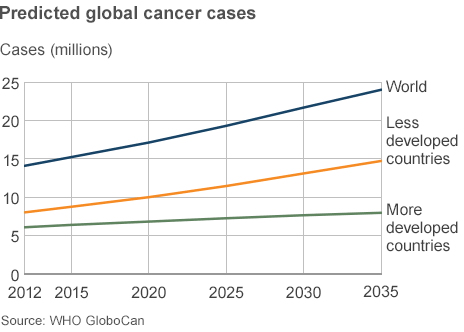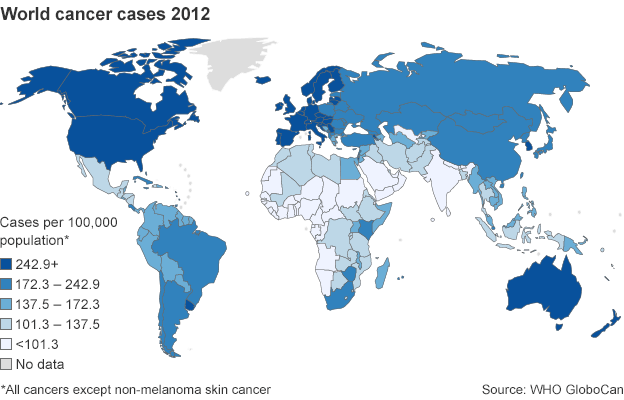According to French researchers, the incidence of cancer is expected to increase by more than 75% by the year 2030 in developed countries, and over 90% in developing nations. The study is published Online First in the Lancet Oncology.
The researchers, led by Dr Freddie Bray of the International Agency for Research on Cancer (IARC) in Lyon, France, set out to determine how the current and future patterns of incidence and mortality of different types of cancer vary between nations with different levels of development, as measured by their Human Development Index (HDI).
In nations transitioning towards higher levels of human development, there appears to be a reduction in incidence rates of some types of cancer, such as stomach cancer and cervical cancer. However, the incidence of breast, colorectal, and prostate cancer is expected to increase substantially in higher-HDI countries.
Dr Bray explained:
“Cancer is already the leading cause of death in many high-income countries and is set to become a major cause of morbidity and mortality in the next decades in every region of the world; this study serves as an important reference point in drawing attention to the need for global action to reduce the increasing burden of cancer.”
Using data from GLOBOCAN, the researchers examined estimates of cancer incidence and mortality in 2008 in 184 countries. The team found the patterns of the most prevalent types of cancer varied according to four levels of human development.
The team then used these findings to project how the burden of cancer is likely to change by the year 2030. Their projections took into account predicted changes in population size and aging, in addition to the changing trends in incidence rates of 6 of the most prevalent types of cancer in nations with medium, high, and very high levels of HDI.
At present, there is a high incidence of cancers associated with infection in nations with a low HDI (mainly countries in sub-Saharan Africa), particularly cervical cancer, as well as stomach cancer, liver cancer and Kaposi’s sarcoma, depending on the region or country. By contrast, the burden of lung, breast, colorectal and prostate cancer is greater in countries with a higher HDI, such as the UK, Russia, Australia, and Brazil.
According to the researchers, by 2030, the number of cancer cases are expected to increase by 78% in medium HDI countries, such as China, India, and South Africa, and by 93% in low HDI countries.
The researchers also found the following trends:
- Even though very high HDI countries only contain 15% of the world’s population, they accounted for 40% of cancer cases in the world in 2008.
- Although the incidence of stomach and cervical cancer is decreasing in nations with medium, high, or very high levels of HDI, there are a number of exceptions for cervical cancer.
- The incidence of female breast cancer and prostate cancer seems to be increasing in the majority of countries currently with medium, high, or very high levels of HDI.
- Lung cancer incidence rates appears to be decreasing in men in countries with high and very high HDI levels, but increasing in women.
- Although lung cancer is currently not a leading cancer in low HDI regions, it will become a leading cause of cancer unless tobacco smoking is controlled in these areas.
Dr Christopher Wild, International Agency for Research on Cancer Director, explained:
“This study reveals the dynamic nature of cancer patterns in a given region of the world over time. Countries must take account of the specific challenges they will face and prioritize targeted interventions to combat the projected increases in cancer burden via effective primary prevention strategies, early detection, and effective treatment programs.”





